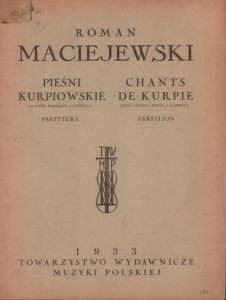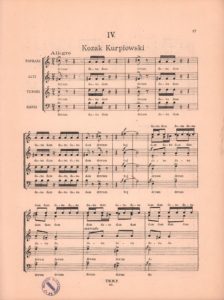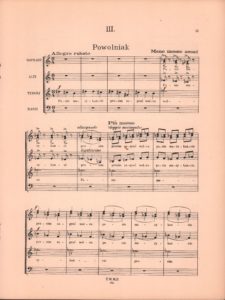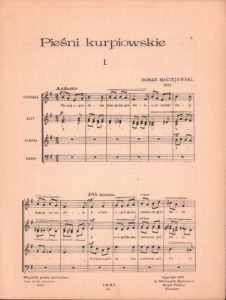Kurpie Songs for mixed choir is a cycle comprising four songs: “Nie mój ogródusek”, “A cemu”, “Powolniak” and “Kozak kurpiowski”. The composition was most likely inspired by Karol Szymanowski’s Kurpie Songs. In creating their own musical material both composers used the same folk original, Władysław Skierkowski’s collection Puszcza kurpiowska w pieśni, a book which popularised the hitherto little-known folklore from the Kurpie region.
The date of the writing of Maciejewski’s piece is not known for certain; the first edition features the year 1932 (and this classification dominates), but various sources suggest that it may have been written even four years earlier.
An undoubted asset of the songs is the sophisticated compositional technique, which is used not only to create an original artistic quality, but also to present the nature of Kurpie music. In addition to quotations the composer uses modal scales, simple formal patterns (ABA1), pedal notes (although here they also appear as the tonal centre) or empty fifths. The rhythm is simple and in the fourth song very motoric, truly “Bartókian”. This energetic wedding dance, a Cossack dance from the Kurpie region, is based on asemantic words (e.g. drum, dana, hej), which brings to mind the style of a folk band. A very important element in the whole cycle is sound colour (including topophonic ideas), changing dynamics, agogics and tempo rubato.
Maciejewski’s Kurpie Songs surprise the listeners not just with their original, refined harmonies, but also with the composer’s individual approach to the words, constituting an example of a synthesis of Polish folk music tradition and modern compositional techniques. These elements make the songs part of a modern concept of national style and – despite being inspired by the achievements of Karol Szymanowski – are a proposal separate from that of the old master, a proposal marked by technical maturity and stylistic cohesion. As Małgorzata Komorowska writes, “they are some of the finest choral pieces in our repertoire of the inter-war period and represent settings of Polish folklore of the highest quality (M. Komorowska, “O pieśniach kurpiów”, “Nie mój ogrudusek”, DUX 1998, CD 0116).
- R. Maciejewski, The Kurpie Songs, cover
- R. Maciejewski, The Kurpie Songs, score excerpt, no. 4
- R. Maciejewski, The Kurpie Songs, score excerpt, no. 3
- R. Maciejewski, The Kurpie Songs, score excerpt, no. 2
- R. Maciejewski, The Kurpie Songs, score excerpt, no. 1




